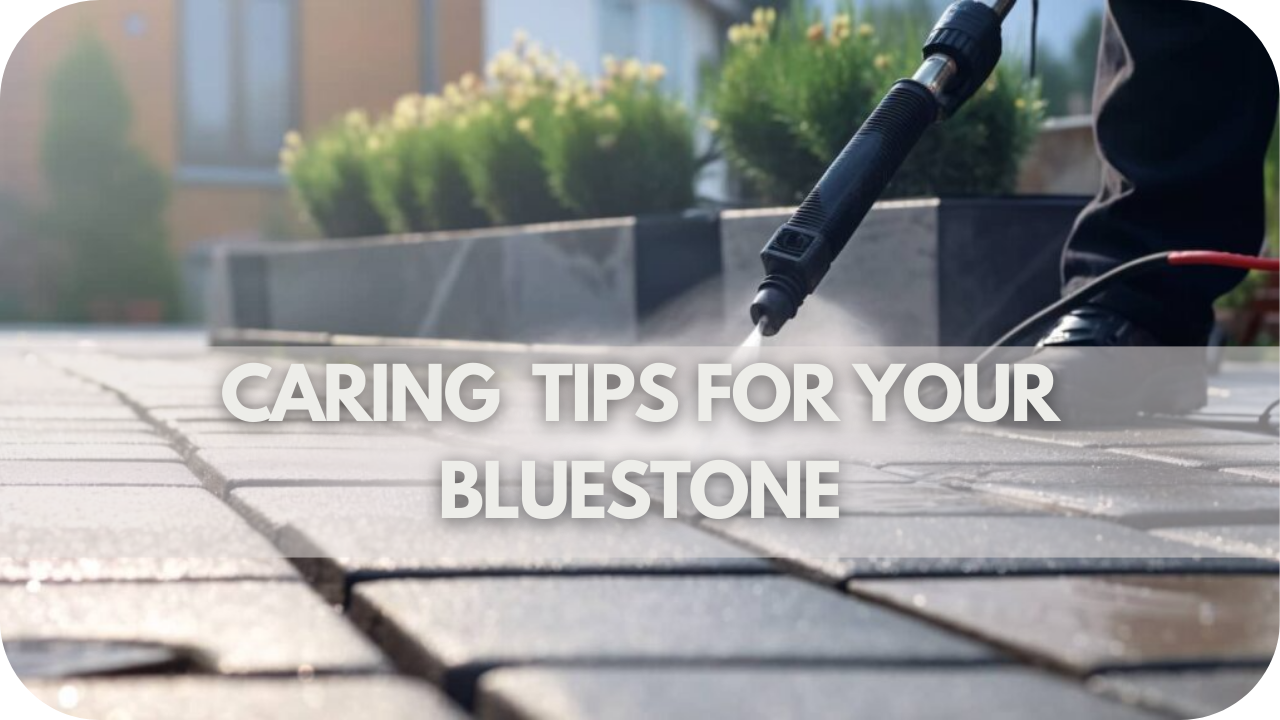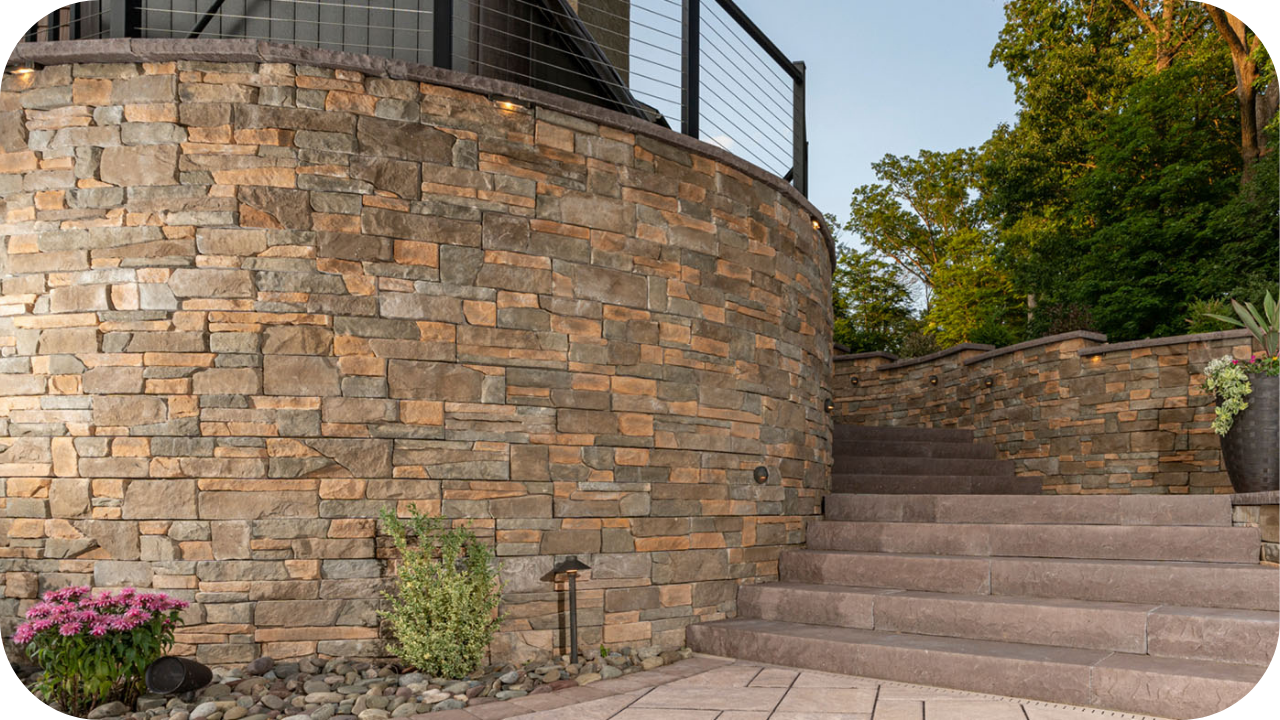
Bluestone is celebrated for its enduring beauty, but neglect can lead to wear and dullness over time. With the right care, your Bluestone surfaces can maintain elegance and withstand the elements.
Imagine your patio or floors looking flawless year after year with just a few simple maintenance steps. Follow these expert maintenance tips to protect and enhance your Bluestone’s natural charm, ensuring its lasting beauty and resilience for the future.
Tip 1: Regular washing and cleaning
Regular cleaning is the simplest way to keep your Bluestone looking its best. A consistent routine of sweeping away dirt and debris prevents scratches from forming on the surface. How often should Bluestone be washed? Aim for a weekly rinse with water to remove loose particles and a more thorough clean with a pH-neutral stone cleaner once a month.
Use a soft-bristle brush to scrub gently for tougher grime without damaging the stone’s finish. Avoid high-pressure washing, as it can degrade Bluestone over time, wearing away its smooth surface. Instead, opt for a garden hose, which provides enough water pressure to cleanse the surface without causing harm.
Keeping your Bluestone clean enhances its natural appearance and extends its longevity, reducing the need for costly repairs.
Tip 2: Managing Stains and Discolouration
Stains and discolouration are inevitable with Bluestone, especially in outdoor spaces, but they can be managed effectively. The first step is understanding the source of the stain. For oil stains, a poultice made from baking soda and water can lift the residue, allowing the stone to breathe again.
Organic stains, such as those from leaves, moss, or bird droppings, often respond well to mild detergents or pH-neutral cleaners. Never use acidic cleaners; they can permanently etch the surface of Bluestone, leaving unsightly marks.
Rust stains are more difficult to remove and require specialised stone cleaners. In some cases, applying the cleaner several times may be necessary to remove the rust thoroughly. Acting swiftly is crucial when dealing with any stain, as the longer it sits, the deeper it penetrates the porous stone.
Sealing the Bluestone helps to create a protective barrier, reducing the chances of future staining. Additionally, always rinse the stone thoroughly after cleaning to remove any residue that could cause further discolouration.
Tip 3: Sealing Your Bluestone
Sealing your Bluestone protects it from moisture, stains, and weathering. A high-quality sealant creates a barrier that keeps water and debris from penetrating the stone’s surface. How often should Bluestone be sealed? Experts recommend sealing outdoor Bluestone every one to two years, depending on weather exposure and foot traffic.
Before applying the sealant, it’s vital to clean the surface thoroughly to avoid trapping dirt or stains. Using a roller or sprayer, evenly coat the surface, ensuring full coverage. Allow the sealant to dry completely before using the area to maximise its effectiveness.
Resealing regularly ensures the stone maintains its natural beauty and resilience, preventing costly damage in the future. Proper sealing will protect your Bluestone against the elements while preserving its aesthetic charm for years.
Tip 4: Repairing cracks and chips
Over time, cracks and chips may appear on Bluestone, but addressing them early can prevent further deterioration. Small cracks can be repaired using an epoxy or resin filler, which bonds with the stone to create a smooth finish.
Professional intervention is recommended for larger cracks to avoid complications or further damage. Cleaning the affected area before applying filler ensures a solid bond.
Once the crack is filled, gently smooth the surface to match the surrounding Bluestone. A patching compound can restore the stone’s original shape for chips, especially on the edges. Prompt repair of these imperfections prevents them from spreading, safeguarding the structural integrity of your Bluestone.
Regularly inspecting the stone for signs of damage will help catch small issues early, minimising the need for more costly repairs. This proactive approach keeps your Bluestone looking pristine and extends its lifespan, preserving its beauty and function.
Tip 5: Inhibiting weed growth
Weeds can be a persistent issue between Bluestone pavers, but proactive measures help keep them at bay. Applying a joint stabilising sealer is highly effective for inhibiting weed growth. This sealer fills the joints, preventing weeds from taking root. How can regular maintenance help? Sweeping frequently removes seeds before they have the chance to germinate. Sand can also fill in gaps between pavers, making growing weeds difficult.
For existing weeds, a natural weed killer, such as vinegar, is a safe option that won’t harm the Bluestone. Chemical weed killers can also be used, but choose products specifically formulated for use on stone to avoid potential damage.
Promptly addressing weed growth helps maintain Bluestone’s clean, sleek look, ensuring it remains a beautiful feature of your landscape. A proactive approach keeps the surface tidy and prevents weeds from loosening the joints, possibly leading to paver displacement over time.
Tip 6: Regular inspections
Regular inspections are key to keeping Bluestone in top condition. By examining your stonework frequently, you can spot minor issues like cracks or chips before they become larger, more expensive problems.
How often should inspections be conducted? Ideally, a visual check every few months will help catch early signs of wear. Pay special attention to high-traffic areas, where wear and tear are more likely.
During an inspection, look for signs of staining, loose pavers, or weeds growing between joints. If any issues are identified, they should be addressed promptly to prevent further damage. Inspecting after extreme weather is especially important, as heavy rain or freezing temperatures can weaken the stone’s structure.
Keeping an eye on your Bluestone helps maintain its beauty and prevents costly repairs in the long run. Staying proactive with regular inspections will extend the lifespan of your Bluestone surfaces, ensuring they remain functional and visually appealing.
Tip 7: Professional repair services
Conducting regular inspections is essential to ensuring the longevity of Bluestone surfaces. By checking the stonework every few months, you can catch minor problems before they become costly repairs. Start by examining high-traffic areas which are more prone to wear and tear.
What should you look for? Cracks, chips, or loose pavers are common signs of damage. Checking for stains or moisture build-up is also crucial, especially in areas exposed to rain or humidity. Inspections are especially important after extreme weather conditions, such as heavy rains or freezing temperatures.
Bluestone is durable, but prolonged exposure to these elements can weaken its structure. Spotting minor issues early allows for timely repairs, preventing damage from spreading and maintaining the stone’s appearance.
Inspections protect against deterioration and help you retain the Bluestone’s aesthetic appeal, ensuring it remains a stunning feature in your landscape or home.
Conclusion
Proper care for your Bluestone ensures its timeless beauty and longevity. For years, follow simple maintenance tips—regular cleaning, sealing, managing stains, and prompt repairs—to protect your investment.
Ready to give your Bluestone the care it deserves? Apply these tips today and keep your stone surfaces pristine for the long haul.
More To Explore

How Can I Prevent Efflorescence From Occurring on Stirling Sandstone?
You’ve just installed stunning Stirling Sandstone, and it looks perfect—but then, white, powdery stains start creeping across the surface. What is it? And more importantly,

Heritage Walling Stone in Point Cook: Ideal for Timeless Homes
Point Cook is a suburb where heritage charm and contemporary design sit side by side. As more homeowners seek to add character and distinction to


